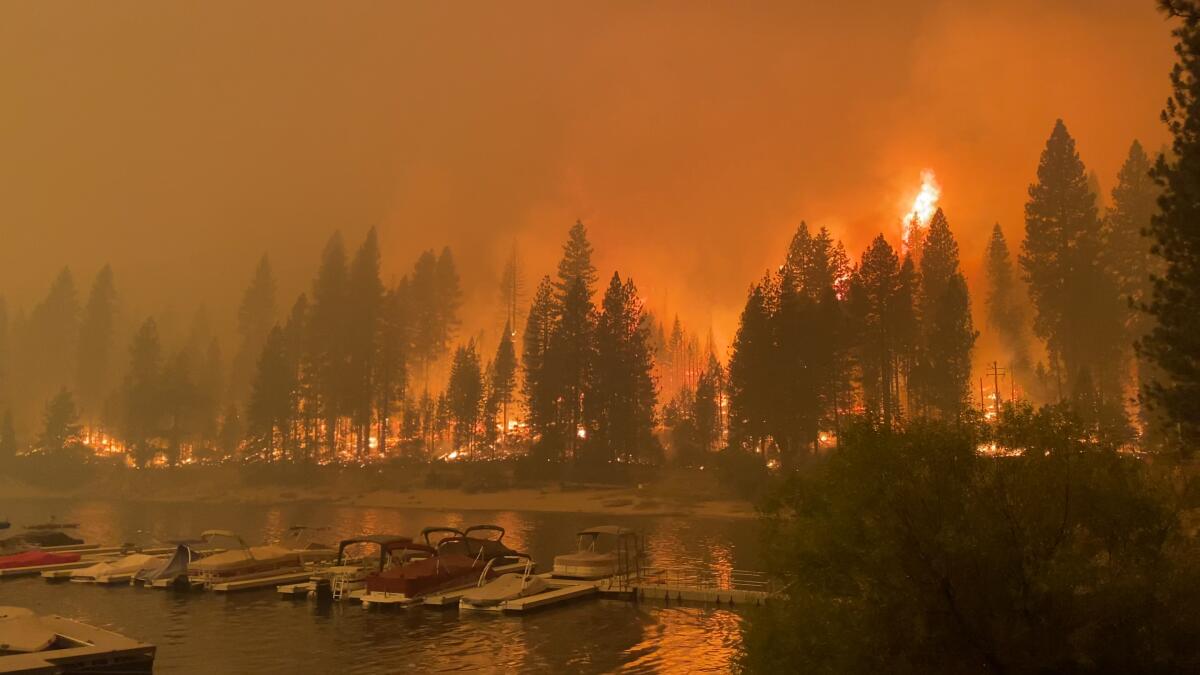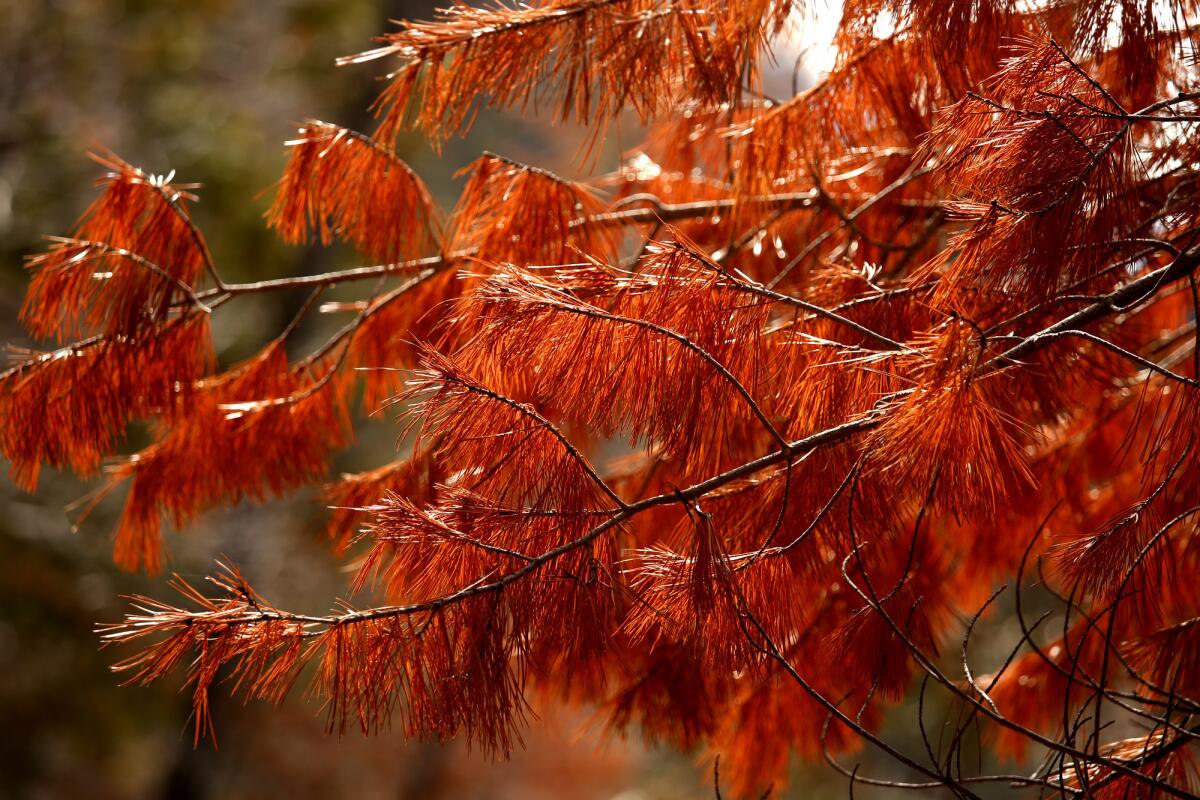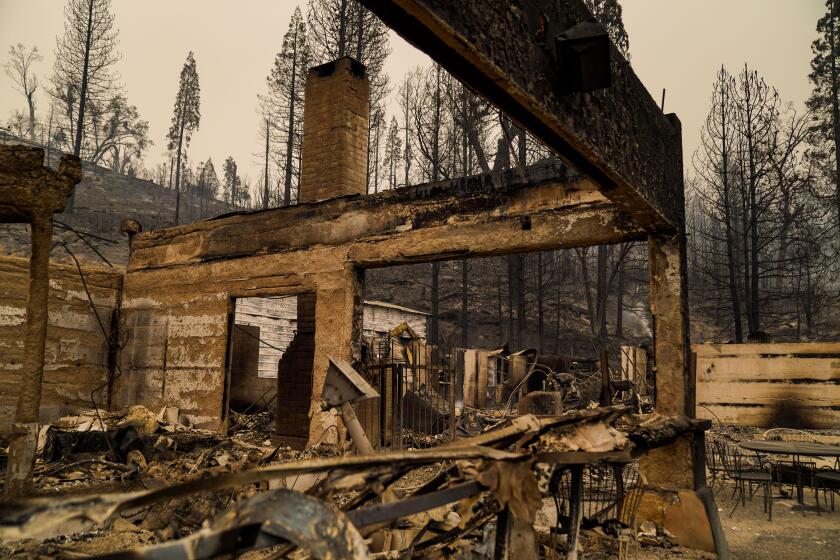150 million dead trees could fuel unprecedented firestorms in the Sierra Nevada

- Share via
Two years ago scientists warned that a massive tree die-off in the Sierra Nevada could set the stage for forest conflagrations akin to World War II fire bombings.
The Creek fire, which forced the dramatic helicopter evacuations of more than 200 campers over Labor Day weekend in California, may be a hint of far worse to come in future years.
It is burning in the Sierra National Forest, an epicenter of the bark beetle attacks that killed nearly 150 million drought-stressed trees during the last decade.
The U.S. Forest Service estimates that dead stands in the Creek fire contain 2,000 tons of fuel per acre.
As of Saturday, the fire had charred more than 196,000 acres, destroyed 365 structures and was threatening 14,000 more in the vicinity of Big Creek, Huntington Lake and Shaver Lake. Firefighters don’t expect to contain it until mid-October.
For those who have studied the potential fire effects of the vast beetle kill, the Creek fire is a harbinger.
“I don’t want to be alarmist. But I think the conditions are there,” said Scott Stephens, a UC Berkeley professor of fire science and lead author of a 2018 paper that raised the specter of future mass forest fires as intense as the Dresden, Germany, and Tokyo firebombings.
“As those [trees] continue to fall, the physics of it are unchanged. If you have dead and downed logs … the fires described in warfare are possible.”
One of hundreds of major blazes to erupt in this record-breaking fire season in California, the Creek fire has underscored the urgency of reducing that monster fuel load.
The only way to do that on the broad, landscape level needed, many experts say, is with fire of a different sort.
“All of us on the paper were suggesting that if you are going to try to reduce that mass fire problem in the future, you really need to start putting prescribed fire into these stands to start whittling away at those bigger fuels,” said Forest Service research ecologist Malcolm North, one of Stephens’ eight co-authors.
While thinning — cutting down the dead timber and hauling it away — can play a role, especially around mountain communities, North said a majority of the beetle-killed stands are in wilderness or in areas that are too remote and too steep to be logged.
Moreover, the dead trees have lost most of their commercial value and are of little interest to the remaining sawmills in California.
The ponderosa pine had taken root decades before the Revolutionary War, making a stately stand on this western Sierra Nevada slope for some 300 years, Nate Stephenson figures.
The Sierra National Forest is well aware of its fire problem. The forest had launched thinning projects around communities, conducted controlled burns on an annual average of 2,000 to 4,000 acres and developed plans to ramp that up to 10,000 acres and eventually as much as 50,000 acres a year.
“They were just getting started,” said Adam Hernandez, who oversaw prescribed fire and fuels management for the Sierra forest before leaving the U.S. Forest Service last year to teach wildland fire technology at Reedley College, southeast of Fresno.
But those big goals are decades late, say fire ecologists. They have long pointed to the mid-elevation pine and mixed-conifer belt of the Sierra Nevada as a place desperately in need of the frequent, low-intensity burns that shaped the forest before settlers and a century of government fire suppression policies snuffed them out.
The elimination of indigenous fire practices, logging of the biggest and most fire-resistant trees and fire suppression produced an overgrown forest vulnerable to bark beetle attacks during the severe California drought of 2012-16.
Some areas have 500 to 800 trees per acre, compared with 60 to 100 pre-settlement. As North puts it, there were too many straws in the dry ground competing for water. The beetle toll was the greatest in the densest stands. There dead fuel will keep piling up for years to come.
Climate change, which accentuated drought severity and is promoting record-breaking heat waves this summer, “is like the frosting on the cake,” said conservationist Craig Thomas.

He has spent years pushing the Forest Service to ramp up prescribed burns. He worked with the Sierra forest staff to develop the ambitious burn plans that environmental groups have backed.
Even regional air quality regulators who limit prescribed burning days are becoming more flexible, Thomas said, as they realize good fire can help prevent the choking air pollution generated by massive wildfires.
But while the Sierra forest staff has the will to conduct 50,000 acres a year of controlled burns, Thomas said, “they don’t have the capacity and the funding to do it.”
Prescribed fire programs aren’t getting the staffing and money they need from the regional and national Forest Service offices, he said.
“How many of these fire seasons do we need before we do the things we need to do?” Thomas wondered. “Every fire scientist I know has been saying it for 30 years.”
Regional Forest Service officials did not immediately respond to an interview request.
Within the agency, North said, “There’s a lot of talk. There’s a lot of attention. The prescribed fire that the Forest Service has put on the landscape has tripled over the last few years and that’s great. But we’re talking about needing to increase prescribed fire by 10 to 12 times” in the Sierra Nevada.
“The thing that is just continuing to bite us in the butt,” he added, “is that rather than being the proactive agents of fire on these landscapes, we’re kind of forcing fire” to occur under the most extreme, destructive conditions. “We’d do a lot better if we were deciding when some of these fires occur.”
The fire was 6% contained Thursday night, and officials said that could grow as weather conditions continue to work in their favor.
Hernandez, who worked on hotshot firefighting crews and in fuels management during his 17 years with the Forest Service, thinks the Creek fire could help propel cultural change.
“We have a culture, and our society, that make it difficult” to return fire to its proper place in the Sierra, he said.
“I can’t tell you how many times we had burns and had to shut down a campground and people were upset because we were ruining their vacation,” he recalled. “We had to explain we are trying to make this a place to come back to in the future.”
Stephens figures California has another decade or so to flatten the trajectory of ever more destructive forest fires. What is needed, he said, is a combination of prescribed fire, restoration thinning and making rural communities more fire resistant.
“If we don’t come out of this year focused on that and try to move forward, I just don’t know if there’s much hope,” he said. “I’m always hopeful. But I’m getting tired.”









